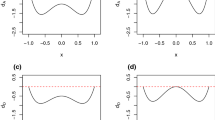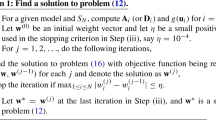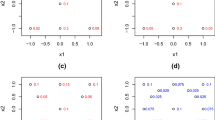Abstract
Compared with the ordinary least squares, the second-order least squares is a more efficient estimation method when the error distribution in a regression model is asymmetric. This paper is concerned with the problem of optimal regression designs based on the second-order least squares estimator under \(I_L\)-optimality which emphasizes the designs to achieve reliable prediction from the fitted regression models. A general equivalence theorem for \(I_L\)-optimality is established and used to check \(I_L\)-optimality of designs. Invariant properties with respect to model reparameterization and linear transformation are also obtained. Several examples are given to illustrate the usefulness of these results.


Similar content being viewed by others
References
Bose M, Mukerjee R (2015) Optimal design measures under asymmetric errors, with application to binary design points. J Stat Plann Infer 159:28–36
Chen X, Tsao M, Zhou J (2012) Robust second-order least-squares estimator for regression models. Stat Pap 53:371–386
Dette H (1997) Designing experiments with respect to ‘standardized’ optimality criteria. J R Stat Soc Ser B 59:97–110
Dette H, Biedermann S (2003) Robust and efficient designs for the Michaelis–Menten model. J Am Stat Assoc 98:679–686
Dette H, O’Brien TE (1999) Optimality criteria for regression models based on predicted variance. Biometrika 86:93–106
Dette H, Studden WJ (1997) The theory of canonical moments with applications in statistics. Probability and analysis. Wiley, New York
Gao LL, Zhou J (2014) New optimal design criteria for regression models with asymmetric errors. J Stat Plan Infer 149:140–151
Gao LL, Zhou J (2017) \(D\)-optimal designs based on the second-order least squares estimator. Stat Pap 58:77–94
He L (2018) Optimal designs for multi-factor nonlinear models based on the second-order least squares estimator. Stat Probab Lett 137:201–208
He L, Yue R-X (2019) \(R\)-optimality criterion for regression models with asymmetric errors. J Stat Plan Infer 199:318–326
Huda S, Mukerjee R (2018) Optimal designs with string property under asymmetric errors and SLS estimation. Stat Pap 59:1255–1268
Kiefer J (1974) General equivalence theory for optimum designs (approximate theory). Ann Stat 2:849–879
Kim M, Ma Y (2011) The efficiency of the second-order nonlinear least squares estimator and its extension. Ann Inst Stat Math 64:751–764
Liu X, Yue R-X, Hickernell FJ (2011) Optimality criteria for multiresponse linear models based on predictive ellipsoids. Stat Sin 21:421–432
Liu X, Yue R-X, Lin DK (2013) Optimal design for prediction in multiresponse linear models based on rectangular confidence region. J Stat Plan Infer 143:1954–1967
Masoudi E, Holling H, Wong WK (2017) Application of imperialist competitive algorithm to find minimax and standardized maximin optimal designs. Comput Stat Data Anal 113:330–345
Paquet-Durand O, Zettel V, Hitzmann B (2015) Optimal experimental design for parameter estimation of the Peleg model. Chemom Intell Lab Syst 140:36–42
Pukelsheim F (1993) Optimal design of experiments. Wiley, New York
Rosadi D, Filzmoser P (2019) Robust second-order least-squares estimation for regression models with autoregressive errors. Stat Pap 60:105–122
Wang L, Leblanc A (2008) Second-order nonlinear least squares estimation. Ann Inst Stat Math 60:883–900
Wang X, Yang M, Zheng W (2019) Optimal designs for nonlinear models with random block effects. Stat Sin 29:283–302
Whittle P (1973) Some general points in the theory of optimal experimental designs. J R Stat Soc Ser B 35:123–130
Yeh C, Zhou J (2019) Properties of optimal regression designs under the second-order least squares estimator. Papers, Stat. https://doi.org/10.1007/s00362-018-01076-6
Yin Y, Zhou J (2017) Optimal designs for regression models using the second-order least squares estimator. Stat Sin 27:1841–1856
Acknowledgements
This work was partly supported by the National Natural Science Foundation of China under Grants (No. 11971318, 11871143), the Natural Science Foundation of Anhui Province under Grant (No. 2008085QA15) and Shanghai Rising-Star Program (No. 20QA1407500). The authors are also grateful to the referees for their useful comments and valuable suggestions.
Author information
Authors and Affiliations
Corresponding author
Additional information
Publisher's Note
Springer Nature remains neutral with regard to jurisdictional claims in published maps and institutional affiliations.
Appendix: The derivation of the analytical results in Example 2
Appendix: The derivation of the analytical results in Example 2
Let \(\eta _j=\int _{{\mathcal {X}}}x^j\xi (dx)\) be the jth moment of x based on the design measure \(\xi \). We have \(g_1(\xi )=\begin{pmatrix}\eta _1\\ \eta _2\end{pmatrix}\) and \(G_2(\xi )=\begin{pmatrix}\eta _2&{}\eta _3\\ \eta _3&{}\eta _4\end{pmatrix}\). From Theorem 4 the criterion function \(\psi _L(\xi )\) in (6) is invariant with respect to the reflection of both x and z, then we just need to focus on a symmetric design measure, say \({\bar{\xi }}\), on \({\mathcal {X}}=[-1,1]\) in order to construct \(I_L\)-optimal designs. For all the moments \(\eta _j\), we have \(\eta _1=\eta _3=0\) under symmetric designs, and the even moments of any design measure satisfy \(0\le \eta _2^2\le \eta _4\le \eta _2\le 1\) from Dette and Studden (1997). The following is an explicit derivation for the case \(L=0\), the others can be derived similarly and are omitted for saving space.
For \(L=0\), the criterion function \(\psi _L(\cdot )\) in (6) under symmetric designs simplifies to
then the \(I_0\)-optimal design \(\xi _0^*\) can be achieved through solving the following optimization problem:
Denote the above-mentioned objective function by \({\widetilde{\psi }}_0(\eta _2,\eta _4)\), a straightforward calculation yields \(\partial {\widetilde{\psi }}_0(\eta _2,\eta _4)/\partial \eta _4\le 0\), which implies \({\widetilde{\psi }}_0(\eta _2,\eta _4)\) decreases in \(\eta _4\) for a fixed \(\eta _2\) and attains its minimum at \(\eta _4=\eta _2\). It follows that the design \(\xi _0^*\) belongs to the set of symmetric designs of the following form
for some \(\omega \in (0, 1]\), and the objective function \({\widetilde{\psi }}_0(\eta _2,\eta _4)\) can be rewritten as
Therefore, \({\widetilde{\psi }}_0(\omega )\) is minimized at \(\omega =\min \{1,\omega _0^*\}\) where \(\omega _0^*\) is the root of \(\partial {\widetilde{\psi }}_0(\omega )/\partial \omega =0\), which is equal to (15). This completes the derivation.
Rights and permissions
About this article
Cite this article
He, L., Yue, RX. \(I_L\)-optimal designs for regression models under the second-order least squares estimator. Metrika 85, 53–66 (2022). https://doi.org/10.1007/s00184-021-00819-0
Received:
Accepted:
Published:
Issue Date:
DOI: https://doi.org/10.1007/s00184-021-00819-0
Keywords
- Optimal designs
- Second-order least squares estimator
- Predicted variance
- General equivalence theorem
- Invariance




